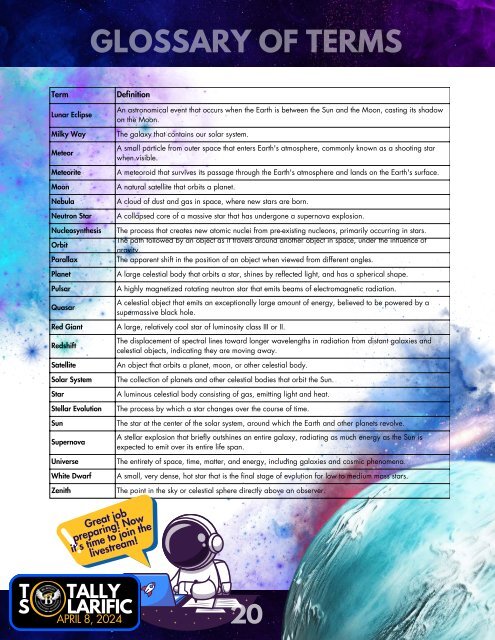BAA Solar Day Guide Version 2.0
Create successful ePaper yourself
Turn your PDF publications into a flip-book with our unique Google optimized e-Paper software.
GLOSSARY OF TERMS<br />
Term<br />
Lunar Eclipse<br />
Milky Way<br />
Meteor<br />
Meteorite<br />
Moon<br />
Nebula<br />
Neutron Star<br />
Nucleosynthesis<br />
Orbit<br />
Parallax<br />
Planet<br />
Pulsar<br />
Quasar<br />
Red Giant<br />
Redshift<br />
Satellite<br />
<strong>Solar</strong> System<br />
Star<br />
Stellar Evolution<br />
Sun<br />
Supernova<br />
Universe<br />
White Dwarf<br />
Definition<br />
An astronomical event that occurs when the Earth is between the Sun and the Moon, casting its shadow<br />
on the Moon.<br />
The galaxy that contains our solar system.<br />
A small particle from outer space that enters Earth's atmosphere, commonly known as a shooting star<br />
when visible.<br />
A meteoroid that survives its passage through the Earth's atmosphere and lands on the Earth's surface.<br />
A natural satellite that orbits a planet.<br />
A cloud of dust and gas in space, where new stars are born.<br />
A collapsed core of a massive star that has undergone a supernova explosion.<br />
The process that creates new atomic nuclei from pre-existing nucleons, primarily occurring in stars.<br />
The path followed by an object as it travels around another object in space, under the influence of<br />
gravity.<br />
The apparent shift in the position of an object when viewed from different angles.<br />
A large celestial body that orbits a star, shines by reflected light, and has a spherical shape.<br />
A highly magnetized rotating neutron star that emits beams of electromagnetic radiation.<br />
A celestial object that emits an exceptionally large amount of energy, believed to be powered by a<br />
supermassive black hole.<br />
A large, relatively cool star of luminosity class III or II.<br />
The displacement of spectral lines toward longer wavelengths in radiation from distant galaxies and<br />
celestial objects, indicating they are moving away.<br />
An object that orbits a planet, moon, or other celestial body.<br />
The collection of planets and other celestial bodies that orbit the Sun.<br />
A luminous celestial body consisting of gas, emitting light and heat.<br />
The process by which a star changes over the course of time.<br />
The star at the center of the solar system, around which the Earth and other planets revolve.<br />
A stellar explosion that briefly outshines an entire galaxy, radiating as much energy as the Sun is<br />
expected to emit over its entire life span.<br />
The entirety of space, time, matter, and energy, including galaxies and cosmic phenomena.<br />
A small, very dense, hot star that is the final stage of evolution for low to medium mass stars.<br />
Zenith<br />
Great job<br />
preparing! Now<br />
it’s time to join the<br />
livestream!<br />
The point in the sky or celestial sphere directly above an observer.<br />
T<br />
S<br />
TALLY<br />
LARIFIC<br />
APRIL 8, 2024<br />
20












